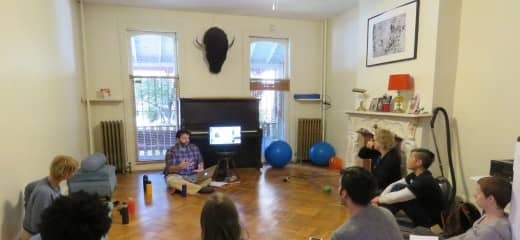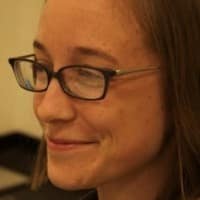What might a choreographer learn from training with an oral historian? Or a dramaturg from a sculptor? What about a group of devised-theater makers from a fiction writer or a digital storyteller? Learning from other fields, in dynamic exchange, seems to be a hallmark of Philadelphia makers. Adrienne Mackey has been leading fascinating experiments called Cross Pollinations, well-documented on the Swim Pony blog. Devised-theater makers Applied Mechanics invited technologist Jorge Just and writer Diane Cook into their research process one weekend earlier this fall. Supported by a grant from the Network of Ensemble Theaters, this research lays the groundwork for a 2018 premiere focused on documenters, people who tell stories about the past.
Applied Mechanics is a quintessentially Philadelphia theater ensemble in other ways as well. Their group of collaborators, several of whom have been making work together since 2009, have built trust and rapport over the course of years, a long-term investment in each other. Through their extensive research process, group members do deep dives into relevant source material. There’s an interest in innovation, in getting away from theatrical business as usual. And while they create and tour immersive theatrical works in which audience members are free to choose their own paths through an elaborate designed environment, they also host regular community dinners, and even aerobics parties.
Diane is a fiction writer and a long-time friend of Applied Mechanics’ director Becky Wright. Jorge is a media producer, currently working as an editor with the podcast Heavyweight. Sitting in on the session with Jorge, I observed several areas of overlapping interest:
–They share a concern with empathy. Jorge previously worked for Detour, which creates immersive audio tours for urban neighborhoods. Jorge’s tours were about putting a user into the experience of someone else.
–Both sides are playing with and paying attention to how bodies want to move through space and experimenting with ways of directing the attention of those bodies. Applied Mechanics creates environments for people to explore, but still has structures and arcs in place to direct audience paths. Detour creates a more focused experience for audience members, but also plays with layering time and space.
–Both share a common thread of creating safe and inclusive spaces for both the audience and the performers. Discussing “safety versus fun,” Jorge pointed out that safety can be boring: “You want the world to be both chaotic and predictable.” He talked about Detour’s attempts to tie visual cues into the user’s audio narrative, to relieve anxiety and help them know that they’re on the right track. Becky described the work of Applied Mechanics as “setting up circumstances for delight and discovery.”
–A couple of workshop participants noted that performance and theater people are often interested in the fleshy and the analog, rather than the digital. Applied Mechanics brought Jorge in to work with them in part to challenge this preference, but also because they were intrigued by how podcast listeners, or walking tour users, or fiction readers, might share qualities with theater audiences.
As the group continues their research, company member Thomas Choinacky explains one of his insights from the weekend: “There is a choreography to Detour which balances the predictability of the world, even though it may seem unpredictable to an audience. This also exists in our work, and I’m interested in how we can create new choreographies of our audiences by adding technology or additional ways of mapping our performances.” Becky picked up on a similar element, highlighting the impact of “the conversation about directing the audience’s eye and attention, and what you can and can’t control in their surroundings. I’ll be tuning into how we direct and moderate the audience’s experiences in a different way following that discussion.”






